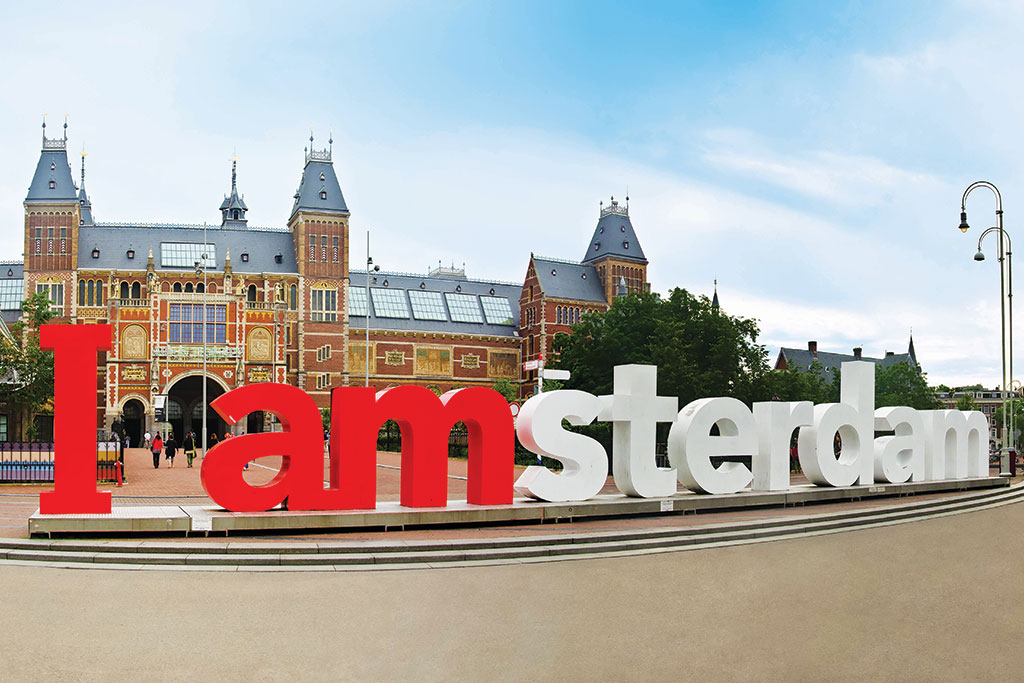When I was 18 years old, I lived in a small town called Wel on a study abroad program as an Emerson College undergrad.
That town in Holland was so indistinguishable, you couldn’t find it on a map, and farm animals outnumbered humans. We lived in a secluded 16th-century castle, though traveled extensively, and I was well immersed in local culture, even able to carry a basic Dutch conversation without today’s handy translator apps.
While Wel was only two convenient hours from Amsterdam, I only visited there a mere handful of times. I wasn’t particularly fond of Amsterdam. It was uninspiring and seedy—chockfull of shady smoke shops with virtually no luxury hotels and mediocre restaurants, heavily relying on museums, canals, and the notorious Red Light District to woo travelers, and nothing more. Amsterdam wasn’t moving like Paris, Rome, Prague, and other top European cities.

Stedelijk Museum
The redemptive factor of having visited in the past is seeing Amsterdam’s slow and steady growth into the future. For 20 years and with deep ties, I watched Amsterdam develop from afar, and I visited regularly every five or so years, eventually feeling a different kind of energy and enthusiasm— and I’m not the only one.
Since 1996, overnight stays increased from four million to 14 million, according to Amsterdam tourism, an astounding number in 20 years. Defying expectations, Amsterdam cultivated a stronger arts scene, banged-out new attractions, and grabbed the attention of travelers with discriminating taste. Five-star hotels began opening doors in centuries-old canal houses, world-class museums received much-needed renovations, and local chefs started giving a damn. Holland’s most well-known city has become progressive without compromising its unique and rich Dutch heritage, proving travelers can experience the best of old and new Amsterdam in one unforgettable visit.
Famous for it’s Rijksmuseum inside the airport, Amsterdam Schipol Airport is set for major expansions to accommodate the 15 million travelers that arrive annually (53 million pass through, ranking it Europe’s fifth busiest airport). While it’s not slated to open until 2023, a new, $560-million terminal was announced, which will further expand the airport to welcome 20 million more travelers. One of the most interesting airports in the world, Schipol offers a new Hilton, notable restaurants and Panoramaterras, a massive, rooftop observation deck that offers supreme viewings of the runway.
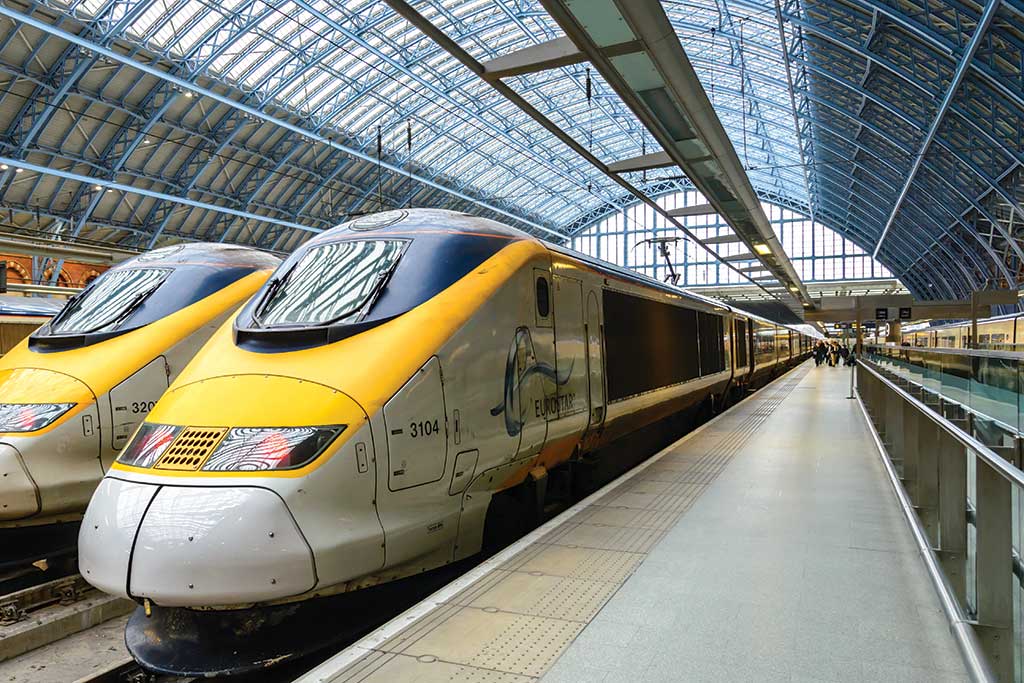
EuroStar
Eurostar (www.eurostar.com), the highspeed rail system in Europe, recently unveiled new $1.4 billion trains that will have an Amsterdam route by the end of 2017. The London to Amsterdam route will be four hours on new trains with free wifi, more space per seat, 300 hours of entertainment via tablet or mobile phone, and a very cushy Business Premier cabin featuring gourmet meals by Michelin starred chef Raymond Blanc.
With Amsterdam’s revival, discerning travelers are rejoicing in the myriad options now available in the hotel landscape. No other city in Europe has had a luxury hotel boom like Amsterdam. In fact, the new fivestar pads are all the buzz in the city, so impressive they have become a lifestyle component for locals who dine in the hotel restaurants, luxuriate in their spas, and imbibe in their cool bars.
Opened in 2014, Waldorf Astoria Amsterdam (Herengracht 542-556 1017 CG, Tel: 31-20-718-4600. www.waldorfastoria.hilton.com. Rooms from $730) is the most luxurious hotel to debut in decades. Housed within six, carefully restored 17thand 18th-century townhomes, Waldorf Astoria Amsterdam oozes with extravagance (think: exquisite fabrics and furnishings, highbrow, afternoon tea, two-Michelin starred restaurant) with suited-up staff and priceless art drenched in sunlight from large windows. The 93-room hotel may be new but it feels timeless, offering a painstakingly manicured garden oasis, a private boat and jetty for canal cruising, Guerlin Spa with indoor swimming pool, and a fine art gallery. With this type of opulence, you’ll want to keep your back straight and shoes polished to fit right in.
The most iconic hotel in Amsterdam, Hotel Pulitzer (Keizersgracht 224, Tel: 31-20-5235235. www.pulitzeramsterdam.com. Rooms from $315) has recently underwent years of renovations and extensions through phases. Opened 45 years ago in ten canal houses, Amsterdam’s first five-star hotel now offers 225 rooms throughout 25 canal houses, in addition to a brand-new, decadent lobby and tucked away, sprawling garden. Opened by Peter Pulitzer, whose grandfather is responsible for the world-renown Pulitzer Prize, this five-star property is one of the most contemporary in Amsterdam, with well preserved design features (original marble floors, stairs, antiques and artwork) and modern amenities (custom made furniture, free WI-FI, and windows that open). History resonates here (Winston Churchill once took the property’s private boat out for a spin on the canal), and a handful of suites have their own private entrances directly to the streets.
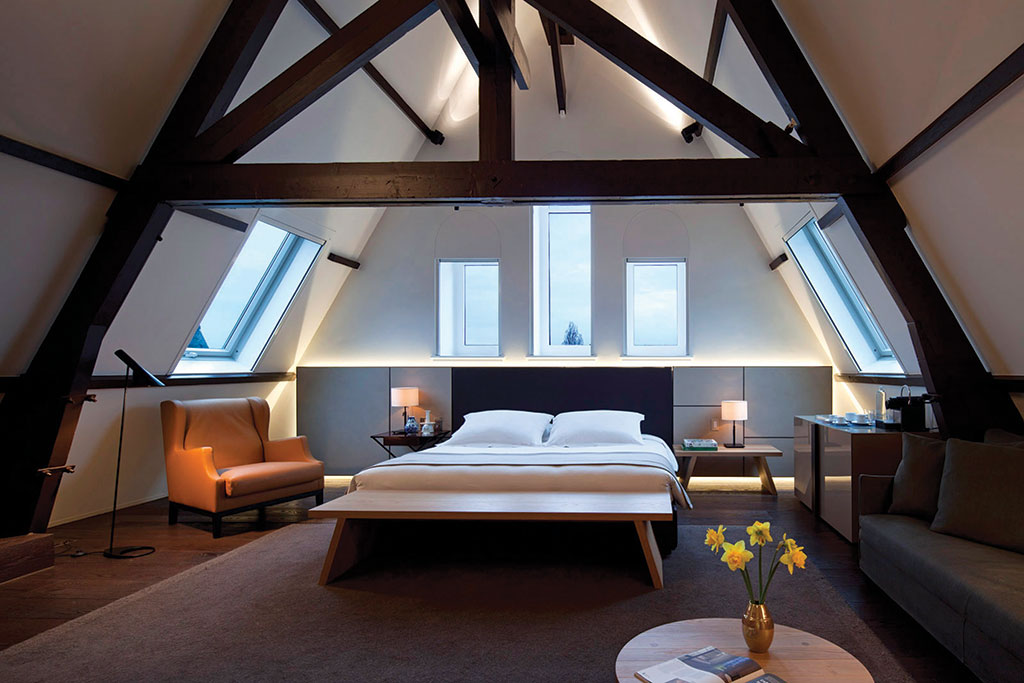
Conservatorium Hotel (I Love Amsterdam Suite)
Original, unique, and unarguably posh, the Conservatorium Hotel (Van Baerlestraat 27, Tel: 31-20-570-0000, www.conservatoriumhotel.com. Rooms from $514) isn’t housed within historic canal houses but rather a monumental, 1897 building that’s served as a former bank and music school. The architecture is breathtaking: an indoor, lobby atrium, floor-to-ceiling windows, rafted glass ceiling, brick-lined walls, and a garden—it’s like a futuristic work of art merging with the past. Spacious rooms come in duplexes, and top-floor suites offer dazzling city views. Opened in 2011, the 129-room hotel, conveniently located next door to Rijksmuseum, is effortlessly the preferred hotel for top visiting celebrities and royalty. Simple touches paying tribute to the hotel’s history (like guest rooms featuring specially designed headphones, and music-themed artwork) are ubiquitous. The spa here is one of the best hotel spas in Amsterdam with a generously sized indoor pool, steam, sauna, pampering treatments, and a large gym equipped with fitness trainers.
Should you want an entire place to yourself, Eleven Experience opened Canal Huis 58 (58 Brouwersgracht, Tel: 31-63-814-8022. www.elevenexperience.com. One night from $5,600) last year. The 18th-century, four-bedroom/four-level townhouse is equipped with modern comforts (all showers have steam, the bar is fully stocked and included, as is complimentary bicycles), and the location, at the intersection of two waterways, is unbeatable. Daily rates include private chef-breakfasts, full bar, well stocked pantry, passes to museums, a guide and more.
If you’ve already visited the world-class museums of Amsterdam, new additions and enhancements will ensure a completely new experience. The ten-year, half-billion renovations at the legendary Rijksmuseum (Museumstraat 1, Tel: 31-20-6747-000. www.rijksmuseum.nl) was so ambitious (and controversial) a documentary was made of the feat. Virtually a brandnew Rijksmuseum was created that’s in line with the 21st century, while still honoring its past. The largest and most visited art museum in Holland has 8,000 works on display including Rembrandts and Vermeers, and is as integral to Amsterdam as its canals, tulips, and windmills.
Next door, the Stedelijk Museum (Museumplein 10, Tel: 31-20-5732-911. www.stedelikj.nl) also underwent major renovations and a 100,000-square-foot extension. The striking building reflects Amsterdam’s progressive flair, and some say the interiors and the structure of the modern art museum is more engaging than the artwork (though their pop art collection featuring works by Warhol and Lichtenstein is impressive).
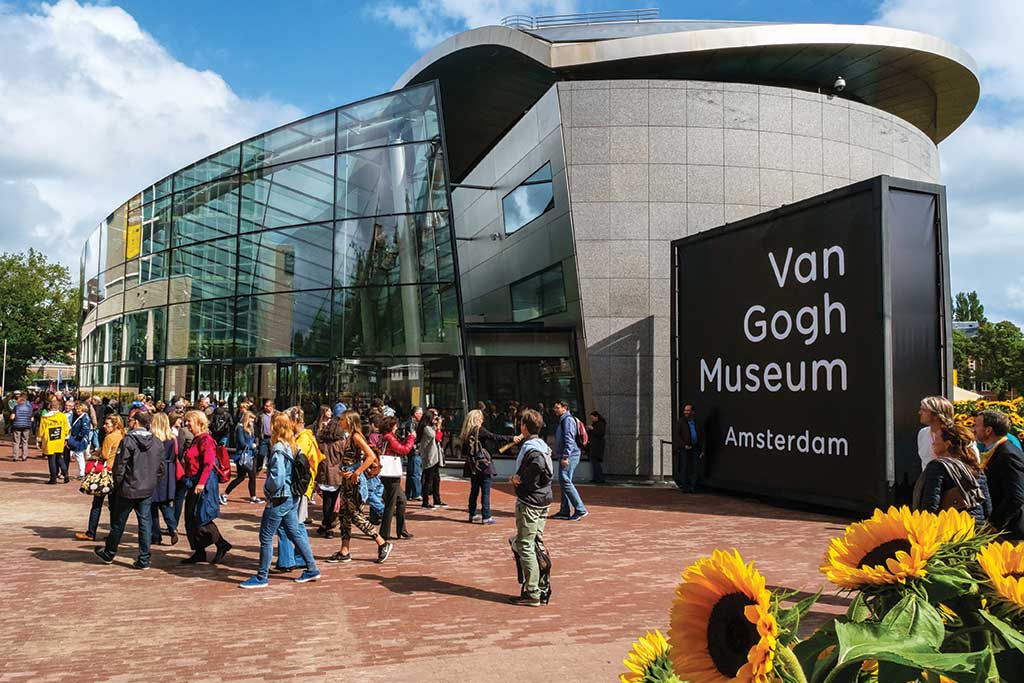
van Gogh Museum
Any cultural visit to Amsterdam isn’t complete without exploring the van Gogh Museum (Museumplein 6, Tel: 31-20-5705200. www.vangoghmuseum.nl). In 2013, it reopened after a $20-million renovation, and the historic museum features more paintings, drawings, letters, and even paintbrushes the famous Dutch painter used.
While Amsterdam is world famous for its Golden Age canals (now an appointed UNESCO World Heritage Site), the islands have proven to be the next big thing. Ferries (or private boats) can whisk you to a number of burgeoning islands like NDSM, a former shipbuilding yard with hangers from the 1920s that now serve as the stomping ground for local hipsters and young families. A stylish restaurant, bar and waterfront, manmade beach (equipped with tire swings and benches) make it the perfect urban oasis as well as a lens into Amsterdam’s desire for growth outside the canal ring. Just north is the arts-driven IJburg Island, featuring a film museum, dance clubs and lounges, and nifty, foundation-less houses that float on water.
Just as exciting as the new frontier in hotels, the restaurant scene has grown 27 percent in the past five years alone, proving there’s more to Dutch dining than cheese and potatoes. Chefs have embraced international flavors and modern techniques, opened restaurants with striking design and elevated overall dining experiences.
Unbelievably, on my previous eight-day visit, there wasn’t enough time to try all the new and notable spots. Luckily, I was able to nab a table at Happy Happy Joy Joy (Bilderdijkstraat 158HS, Tel: 31-20-344-6433. www.happyhappyjoyjoy.asia), an edgy, street foodinspired Asian restaurant that’s boisterous and busy on any given night. Only open a year, it’s so in demand that reservations are necessary for this casual dining spot. HHJJ is animated, trippy, and fun, with Asian-themed posters and murals, popping colors, and paper lanterns, you will feel like you’re in some insane cartoon. In lieu of traditional meals, all dishes are designed for sharing plates inspired by street food and dim sum in China and Southeast Asia (from shu mais to bho khos, panang curry to pad thai).
My favorite meal in Amsterdam was at Jansz (Reestraat 8, Tel: 31-20-5235-282, www.janszamsterdam.com), a sun-drenched, stylish and elegant restaurant in the Nine Streets district. Incidentally, this is my preferred district in Amsterdam: the centuries-old streets are chockablock with modern boutiques, cafes, restaurants, and tasteful souvenir shops.
Jansz is helmed by Cassidy Holman, former sous chef at Momofuku in NYC, who serves up modern classics with a subtle Dutch touch (Dutch oysters and duck-liver mousse with truffle is a highlight, and the Reypenaer cheeseburger is TDF), with everything in-house made from scratch (down to the syrups). The entrance is actually an old pharmacy, complete with vintage apothecary jars and a tiled-floor.
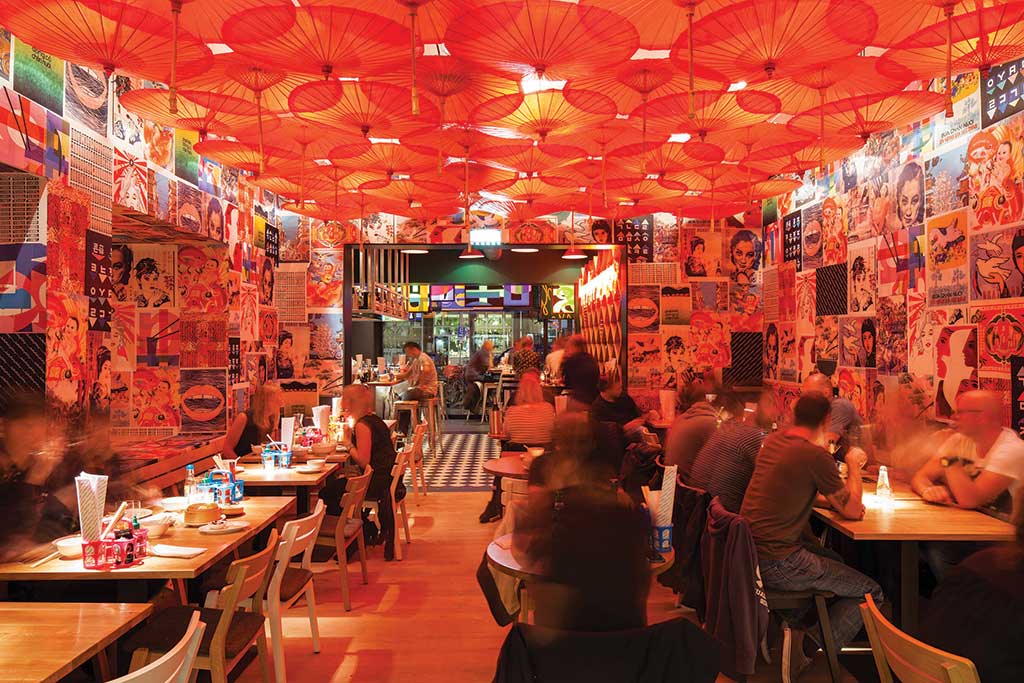
Happy Happy Joy Joy
While you’re in Amsterdam, make sure to visit Breda (Singel 210, Tel: 31-20-622-5233. www.breda-amsterdam.com), the restaurant of the moment, which was opened in December 2015 by a pair of twentysomethings local chef heroes, Freek van Noortwijk and Guillaume de Beer, and co-owner Johanneke van Iwaarden. Breda is their second venture (after popular hot spot Guts & Glory), showcasing the best of Southern Netherlands culinary scene (Breda is the name of the small town they were born). The elegant tasting menu includes rich and perfectly seasoned dishes (from soft belly pork, duck and cauliflower fried in beurre noir and freshly grated black truffle) that flaunt originality and creativity.
Gay history flourishes in Amsterdam. Not only was homosexuality decriminalized here in 1811, the first gay bar in Europe opened here in 1927. The Netherlands was also the first country in the world to legalize same-sex marriage (2001), so calling Amsterdam “gay friendly” is largely an understatement. It’s not unusual to find gay happenings throughout the city (even canalside circuit parties) at any random moment, and the nightlife scene remains solid for gay travelers.
While there aren’t many new businesses considering the healthy number of spots that are already thriving in the gayborhood Reguliersdwarstraat, Church (Kerkstraat 52, Tel: 31-20421-0392. www.clubchurch.nl), opened in 2008, remains the most booming and over-thetop club. Think Greek columns, impressive lighting and sound system, and plenty of dark nooks and chambers to keep the surprises coming until the wee hours of the morning.
Relive history at Cafe ’T Mandje (Zeedijk 63, Tel: 31-20-622-5375. www.cafetmandje.nl), the first gay bar in Amsterdam (and all of Europe), It’s a true institution that’s lively and cramped on the weekends with plenty of eye candy (from the fun and quirky memorabilia to the diversity of the boys that hang out here), and the cocktails are as stiff as they come.
Speaking of booze, Ketel One, the gay man’s favorite highbrow vodka, is based right outside of Amsterdam, and celebs like Leon Bridges and Fashion Blogger Bryan Boy have been heading to the Nolet Distillery (Hoofdstraat 14, Tel: 31-10-246-2929. www.noletdistillery.com) for proper Ketel One lovin.’ The family-run distillery, just 45minutes outside the city, features new VIP experiences, a theater, engaging tours and, of course, premium vodka tastings.
With impressive new luxury hotels, renovated, world-class museums, a modern culinary movement, and thriving LGBT culture, Amsterdam is a classic city that never fails to inspire. Travelers are finding more reasons to explore (and rediscover) this city that’s reinventing itself as a worldclass destination. Amsterdam’s renaissance is a force to be reckoned with, and it’s come a long way for a city with only 600,000 residents. As most travelers would agree, there’s always something new with every visit, and I know I’ll be back soon. As they say in Holland, “Gezelligheid kent geen tijd (time spent together is time well spent!), and my relationship with Amsterdam will only deepen from here.
You may also enjoy WorldEats: Amsterdam


